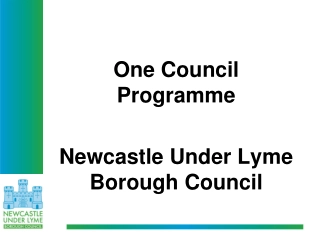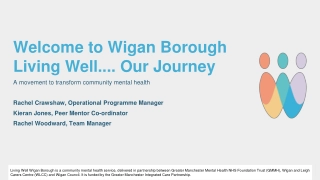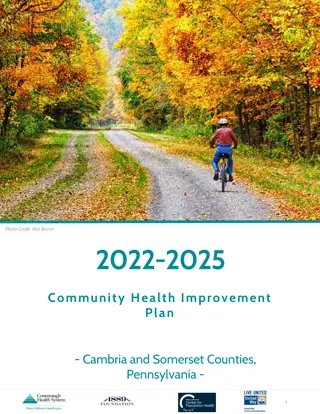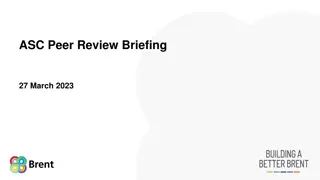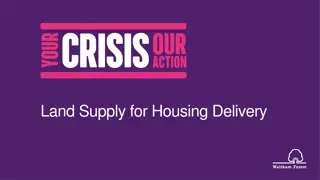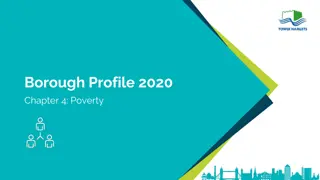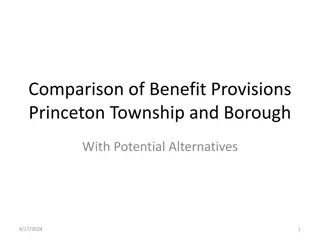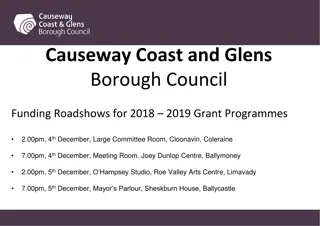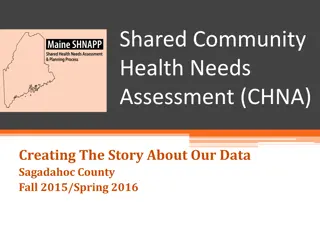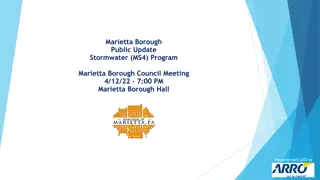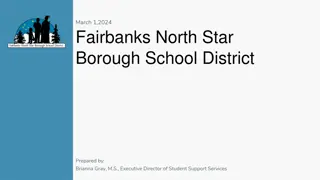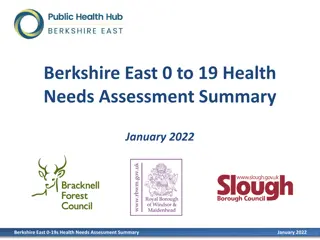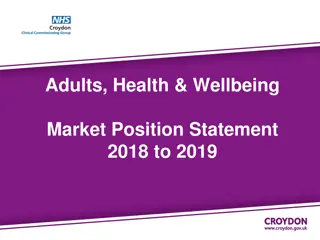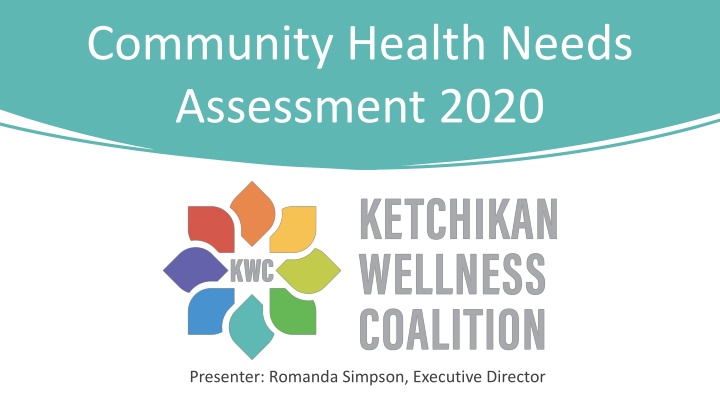
Insights into Community Health Needs Assessment 2020 in Ketchikan
Explore the key findings from the Community Health Needs Assessment in Ketchikan, focusing on poverty rates and housing challenges. Discover insights on priority health needs and demographic data to drive targeted partnerships and improvements in the community.
Uploaded on | 1 Views
Download Presentation

Please find below an Image/Link to download the presentation.
The content on the website is provided AS IS for your information and personal use only. It may not be sold, licensed, or shared on other websites without obtaining consent from the author. If you encounter any issues during the download, it is possible that the publisher has removed the file from their server.
You are allowed to download the files provided on this website for personal or commercial use, subject to the condition that they are used lawfully. All files are the property of their respective owners.
The content on the website is provided AS IS for your information and personal use only. It may not be sold, licensed, or shared on other websites without obtaining consent from the author.
E N D
Presentation Transcript
Community Health Needs Assessment 2020 Presenter: Romanda Simpson, Executive Director
Objectives Identify priority health needs and focus areas in Ketchikan. Utilize data to determine opportunities and partnerships that will best serve those needs The Assessment Timeline of Assessment September November 2020 Consultants Crescendo
Stakeholder Interviews: Sixteen (16) interviews with key stakeholders from various sectors (healthcare, mental health/substance use, education, public safety, community non-profits) Focus Groups: Four groups of general community members Community Survey: 186 complete survey responses. Quantitative data collected and summarized into top needs. Access Audit: randomized cold calls to service providers in Ketchikan as a potential client . Secondary Research Data: obtained from a range of State, Federal, local and community data sets Methodology
Demographics Of the approximately 14,000 individuals living in the Ketchikan Gateway Borough, 10.5% live below the poverty line. City of Ketchikan is higher, at 12.6%. The median income in the City of Ketchikan is lower than the Gateway Borough and Southeast Alaska. Ketchikan has a higher percentage of youth under the age of 18 than Southeast Alaska. Ketchikan has a high percent (18%) of single-parent households than Southeast Alaska.
Key Insights - Poverty Poverty rates are slightly higher in the City of Ketchikan than comparative regions. 27.6% of Alaskan Natives/American Indians in the City of Ketchikan live in poverty Ethnic minorities experience poverty at a higher rate than white individuals. Poverty Rates by Race/Ethnicity 35.0% 31.4% 30.0% 27.6% 25.0% 20.0% 17.2% 15.0% 9.6% 10.0% 4.5% 5.0% 1.8% 0.0% White Black or African American Hispanic or Latino American Indian/Alaska Native Metlakatla Asian Other Ketchikan Ketchikan Gateway Borough Southeast Alaska
Key Insights - Housing Housing Burden and Occupancy* Over half of renters in Ketchikan (56.2%) are housing cost burdened. The Southeast Alaska rate of cost burdened renters is 39.6%. The City Ketchikan Ketchikan Gateway Borough Metlakatla Southeast Alaska (Inner Passage) Owner Occupied There is very little housing for sale or rent in the Ketchikan Gateway Borough, with just a 1% owner vacancy rate, and a 6.9% rental vacancy rate. However, 16% of overall housing units in the region are vacant, and not for sale or rent - double the Southeast Alaska average. This may present an opportunity to renovate housing units in the region for purchase/rental. 49.3% 60.8% 74.0% 64.0% Renter Occupied 50.7% 39.2% 26.0% 36.0% Housing Cost Burdened (Owner) Housing Cost Burdened (Renter) Vacant Housing Units 31.2% 29.6% 8.7% 28.6% 56.2% 53.2% 28.9% 39.6% 15.5% 16.0% 11.3% 8.4% Owner Vacancy 1.3% 1.0% 0.0% 2.2% Renter Vacancy *a household is cost burdened when it spends greater than 30% of income on housing 5.8% 6.9% 7.9% 2.9% SOURCE: American Community Survey, 2013-2018 5-Year Estimates, ESRI Data 2020
Key Insights Access & Utilization More services are needed. We have a good number of providers, but many don't accept Medicaid, or many providers are booked for months and people just end up going to the Emergency Department. Ketchikan Gateway Borough Prince of Wales- Hyder Census Area (Metlakatla) Alaska United States The Ketchikan Gateway Borough has a much higher rate of uninsured adults (17.5%) than the national average (12.5%). 17.5% 22.8% 16.3% 12.5% Uninsured Adults Black or African American residents average the most uninsured population by race in Ketchikan. Uninsured Children 10.9% 13.7% 8.8% 5.2% Native American or Alaska Native persons are the second likeliest to be uninsured, at 22.5%, though there are services in the region aimed directly at helping indigenous populations. 0.6% 1.3% 1.2% 0.8% Uninsured Elderly The Asian community is uninsured at a rate of 11.3% in Ketchikan. Avoidable Hospitalizations 2,937 ND 2,809 4,624 The high rate of mental health providers in the region suggests an understanding that mental health treatment is much needed in the area. However, most do not accept Medicaid/Medicare. Rate of Primary Care Physicians 100.8 77.3 91.0 76.6 Rate of Mental Health Providers 273.0 124.6 433.4 202.8 SOURCE: Behavioral Risk Factor Surveillance System (BRFSS) Healthy People 2020. 2016.
Preventive Lifestyle Measures Key Insights Prevention Ketchikan Gateway Borough Prince of Wales- Hyder Census Area (Metlakatla) Alaska United States Adults who are Obese 38.4% 39.6% 31.8% 29.5% Percentage of Adults Current Smokers Preventive Health Measures 22.7% ND 20.2% 18.1% Ketchikan Gateway Borough Prince of Wales- Hyder Census Area (Metlakatla) Alaska United States Percentage of Adults Reporting Binge or Heavy Drinking 21.6% ND 18.7% 16.9% Mammogram Screening 24% ND 28% 32% SOURCE: Behavioral Risk Factor Surveillance System (BRFSS) Healthy People 2020. 2016. Pap Test 74.2% ND 77.6% 78.5% Rates for preventive tests in the Ketchikan Gateway Borough are lower than state and national rates, which may correlate to cancer being the region s leading cause of death. Sigmoidoscopy or Colonoscopy 49.0% ND 57.8% 61.3% Diabetes Management Hemoglobin A1c Test 80.9% 61.5% 74.6% 85.7% The Ketchikan Gateway Borough has a higher rate of binge drinking, individuals who smoke, and obese adults than comparative regions. SOURCE: Behavioral Risk Factor Surveillance System (BRFSS). Healthy People 2020, 2016.
Key Insights - Causes of Death Suicide rates in Ketchikan are some of the highest rates in the nation. Rates are approximately twice the national average. The leading cause of death in Ketchikan is cancer this is unlike the United States and every state in the country.
Key Insights - Alcohol Premature Death Rates Associated with Substance Abuse, per 100,000 Population Ketchikan Gateway Borough Prince of Wales-Outer Ketchikan Alaska The Alaska average of alcohol induced deaths (19.4) is more double that of the United States average (7.6). All Causes 839.6 829.9 765.9 Alcohol Induced 24.5 36.1 19.4 Ketchikan Gateway Borough has a premature death rate approximately three times the national death rate and 26.3% higher than the state rate. Drug Induced 12.4 ND 14.5 Unintentional Injury 38.0 56.6 55.2 Suicide 30.5 30.9 21.7 Homicide ND ND 5.2 SOURCE: State of Alaska Epidemiologic Profile on Substance Use, Abuse and Dependency. 2013.
Key Insights - Detox Center I have a family member who is living with me who is struggling with heroin. He is technically homeless, and he is afraid. We ve been wondering if there is a detox center. Substance abuse treatment, especially detox, is very limited in this community and many of the services are available in another community, making post-rehab adjustments even more difficult. This is a HIGH need. Without a detox people who want to begin treatment often don t due to wait times. The need for a detox center was mentioned in all four focus groups and almost all 16 stakeholder interviews. It ranked as the highest need in the community survey. A detox center would relieve the pressure on the hospital ER
Key Insights Youth & Substances Binge drinking has reduced by half since 2013. Around 1 in 10 Ketchikan students reported binge drinking in 2019. Prescription drug use without a Dr s approval has decreased since 2013. 1 in 10 Ketchikan students report abusing prescription medication Percentage of Students who Abuse Prescriptions Percentage of Students who Binge Drink 30.0% 35.0% 31.0% 25.7% 30.0% 25.0% 25.0% 20.0% 18.8% 20.0% 15.0% 12.8% 12.7% 15.1% 15.0% 12.4% 12.4% 11.4% 15.0% 10.0% 9.4% 10.0% 5.0% 5.0% 0.0% 0.0% 2013 2015 2019 2013 2015 2017 2019 Ketchikan Alaska Ketchikan Alaska SOURCE: Alaska Youth Risk Behavior Survey. 2013-2019.
Key Insights Youth & Substances Methamphetamine Use (grade 9-12) Heroin Use (grade 9-12) 16.0% 14.0% 14.0% 4.0% 3.7% 3.5% 12.0% 3.0% 10.0% 2.5% 2.2% 8.0% 7.0% 1.9% 2.0% 1.6% 6.0% 1.5% 4.0% 2.6% 1.0% 2.4% 2.2% 2.2% 2.2% 1.9% 2.0% 0.5% 0.0% 0.0% 2013 2015 2017 2019 Ketchikan Alaska Ketchikan Alaska 2017 2019 Approximately 2% of Ketchikan students reported using methamphetamine in 2019, reflecting 16 Ketchikan high schoolers who used meth in the past month. Heroin use is high among Alaska and Ketchikan students, 2.4% and 1.9% respectively. The use of heroin peaked in 2013 and spiked again in 2017. The rates of methamphetamine by Alaska and Ketchikan students are significantly higher than the national average (0.3%; 2016)
Youth Drug Use Prevention Education Youth start experimenting with alcohol around 14 to 17 years. Then they transition to meth, heroin, and pills. Parents are addicted and so are kids. The school district can embrace more consistent education, so every grade gets reinforcing messages each year. We have this in schools, having a community-based program could be really successful. I d like NEW content. Taught to kids in a new way. The school system s struggle to acknowledge there is a problem among the youth with drinking and other substances - kids are dealing with issues at home, and a lot of them don t know how to ask for help.
Percentage of Students who Attempted Suicide Key Insights Youth Mental Health 25.0% 19.7% 20.0% 15.0% 12.1% 11.9% 10.7% 10.3% 10.1% 10.0% 8.4% 7.2% 5.0% Percentage of Students who Seriously Considered Suicide 0.0% 2013 2015 2017 2019 Ketchikan Alaska SOURCE: Alaska Youth Risk Behavior Survey. 2013-2019 The rate of high schoolers in Ketchikan reportedly attempting suicides has risen every year since 2013 One in every nine Ketchikan high schoolers (11.9%) reported attempting suicide. One in every five Alaska high schoolers (19.7%) reported attempting suicide. These numbers are higher than the United States average (7.0%). SOURCE: Alaska Youth Risk Behavior Survey. 2013-2019. The number of students who have seriously considered suicide in Alaska has risen around 10% since 2013, whereas rates in Ketchikan have fluctuated between 26% and 21%.
1. Substance Use treatment and rehabilitation, such as detox 2. Affordable Housing 3. Affordable, quality childcare 4. Case workers/navigators for people with mental health/substance use challenges Top Overall Needs Community Survey Results * ranked by % that stated much more focus needed 5. Counseling services for mental health challenges for adolescents/children 6. Substance use education, prevention, early intervention services or adolescents/children 7. Counseling services for mental health issues for adults 8. Healthcare services for people experiencing homelessness 9. Urgent care services 10.Social services (other than healthcare) for people experiencing homelessness
Community Needs Top Themes Access to Affordable Housing: the limited supply of affordable housing options and limited assistance provision is not meeting the current need. Housing is a major problem - is there a middle class here? You can either afford a house or apartment here or you're out of luck. Housing is a tremendous barrier in our town and can lead to unsafe living conditions for families Homelessness: There are unique needs for the homeless population. I would like to see a plan - not just "shelters" as band aid solutions. Services that work together Transportation: Options are limited and can be difficult to access. Transportation to get to doctors appointments and other places can be hard. I have a friend who is struggling with mental health and substance use issues and complains she doesn t have money to get to a dentist appointment.
Community Needs Top Themes Behavioral Health Services: There is a continuing, growing need for services designed to address behavioral health and substance use issues. A detox center would relieve the pressure on the hospital ER Getting people seen quicker so it's not just a crisis response Community Health Services: Long wait times and geographical challenges make accessing current services difficult. Urgent care center would be beneficial for many and free up our Emergency Dept Care coordination is challenging for Ketchikan especially for those who seek care outside of the community (in other parts of AK or in lower 48)
Community Needs Top Themes Covid-19 Impact on Employment: Lack of Tourism is negatively impacting current employment opportunities, which will likely lead to long term impacts within various social determinants of health. Our current economy is very narrow. Youth have limited opportunities to gain experience and opportunities in sectors outside tourism, fishing, construction, sales. Education & Youth Services: Low priority of education and thus a low graduation rate. A need was identified to increase activities and opportunities for youth. I think a lot of youth have nowhere to go, nothing to do if they are not in sports. Affordability or activities with transportation options to those activities for underprivileged youth.
Access Audit Access audit calls were made to 7 behavioral health organizations to identify new patient process, wait times, awareness of other services, and customer service. Key findings: Average wait time was about two weeks for new patient appointments, but often longer for psychiatry services. In conversation, people freely referred callers to other providers as needed. Most calls went to voicemail with no returned call.
KWC Prioritization Primary Priorities Secondary Priorities Need Establishing a detox facility in the community Role Advocate Task Force PIERS Need Establishing caseworkers or "navigators" for people with behavioral health service needs Increasing suicide prevention awareness campaigns and activities Increasing access to drug and other substance abuse education, prevention, and early intervention services for adolescents / children Increasing access to drug and other substance abuse education, prevention, and early intervention services for adults Increasing recreational activities for youth Role Lead Initiative Ketchikan123 Expanding drug and other substance abuse treatment and rehabilitation programs Advocate PIERS Lead & partner Behavioral Health Task Force campaigns Increasing access to counseling services for mental health issues such as depression, anxiety, and others for adults Partner Behavioral Health Lead & partner PIERS education campaigns Improving emergency mental health services, such as a crisis intervention Advocate Behavioral Health Lead & partner PIERS education campaigns Expanding access to sources for affordable, nutritious food Lead & Partner Building a Healthy Community Lead & Partner Ketchikan Youth Alliance
Thank You Romanda Simpson romanda@ktnkwc.org 907-225-9355 ext 6 For full CHNA report go to www.ktnkwc.org

